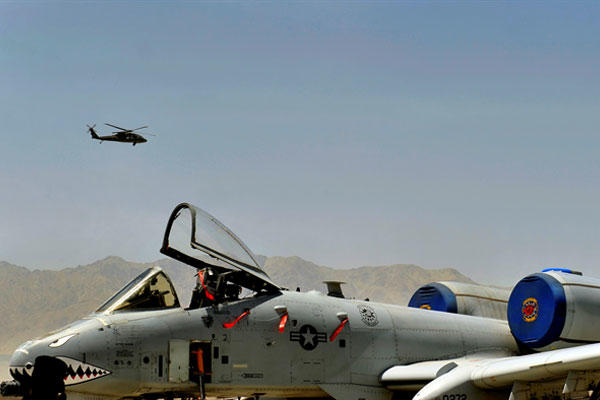BAGRAM AIRFIELD, Afghanistan -- Two A-10 Thunderbolt II pilots assigned to the 74th Expeditionary Fighter Squadron, provided close-air support to 60 U.S. Soldiers July 24.
The Soldiers were part of a routine clearance patrol that was ambushed after their lead vehicle in a convoy of 12 turned over during a patrol of an Afghanistan highway. The situation forced the Soldiers to establish an overnight base while they pulled the vehicle out of a ravine. As the sun rose, the unit began to receive heavy fire from a nearby tree line. The members were pinned behind their vehicles and three of the Soldiers suffered injuries. The unit was under fire and the wounded members needed a casualty evacuation so they called for close-air support.
However, there was one problem; the ground unit didn't have a way to confirm the enemy's position. The unit did have a joint fire observer who was able to communicate an estimated location to the A-10 pilots who arrived on scene shortly after receiving the call from a local base's joint terminal air controller responsible for coordinating aerial engagements.
"I flew over to provide a show of force while my wingman was looking for gunfire below," said the flight lead of the two-ship A-10 mission. "Our goal with the show of force was to break the contact and let the enemy know we were there, but they didn't stop. I think that day the enemy knew they were going to die, so they pushed even harder and began moving closer to our ground forces."
When the enemy combatants didn't flee after the show of force, the A-10 pilots decided to deliver air-to-surface munitions to protect the friendly ground forces.
"Even with all our (top-of-the-line) tools today, we still rely on visual references," said the lead pilot, who is on his first deployment from Moody Air Force Base, Ga. "Once we received general location of the enemy's position, I rolled in as lead aircraft and fired two rockets to mark the area with smoke. Then my wingman rolled in to shoot the enemy with his 30 millimeter rounds."
According to the pilots, that really stirred up the attacking force. The enemy moved even closer to the friendlies in an attempt to prevent the A-10 from attacking again. The ground forces were now taking on a large amount of fire from the trees and surrounding high terrain.
"We just kept putting down more 30 mm rounds," said the second A-10 pilot, also deployed from Moody AFB. "The bad guys were closing in and according to the muzzle flashes there were a lot of them, but because people were shooting all over the place, the JTAC didn't feel safe bringing in helicopters in to evacuate the wounded personnel."
The pilots said usually after the first or second pass, the enemy runs away, but this enemy force was large and willing to fight. The pilots continued to fire 30 mm rounds, but the enemy force refused to fall back. Now, the enemy force was close enough to engage the unit with grenades, so the convoy's commander approved the pilots to engage "danger-close." The term is meant to clearly communicate to the ground and air forces that the need for support is so grave the ground commander is willing to accept the potential risk to the friendly unit for the life-saving employment from the air.
"We train for this, but shooting danger-close is uncomfortable, because now the friendlies are at risk," the second A-10 pilot said. "We came in for a low-angle strafe, 75 feet above the enemy's position and used the 30-mm gun -- 50 meters parallel to ground forces -- ensuring our fire was accurate so we didn't hurt the friendlies.
The engagement lasted two hours that day, and in that time, the A-10s completed 15 gun passes, fired nearly all their 2,300, 30-mm rounds, and dropped three 500-pound bombs on the enemy force.
"That last gun runs must have made them give up," the two pilots agreed "because the firing stopped."
Shortly after the engagement was complete, an MC-12 aircraft specializing in intelligence, surveillance and reconnaissance arrived and began scanning the area for enemy forces that might be regrouping. Sometimes when close-air support leaves, enemy forces will attack again, so the A-10s remained on-station until all the Soldiers were safe.
"We wanted to make sure the area was safe because we had the pararescuemen from the 83rd Expeditionary Rescue Squadron coming to transport the injured to Bagram's hospital," said the second pilot. "The flight doctor assigned to our squadron treated the wounded in the emergency room. It was an example of a successful mission with contributions from all assets of our base."
After the pilots landed and debriefed, they went to the hospital to see the wounded Soldier.
"He was laying there and next to him was a picture of his high-school girlfriend," the lead pilot said. "We were glad knowing we helped get him home alive. He said, 'Thank you for shooting those bad guys'. Luckily we were only a few minutes away and all the friendlies made it out that day."
Providing close-air support is the squadron's main mission here, and is the specialty of the aircraft they fly, the A-10 Thunderbolt II nicknamed the "Warthog."
"This was one of the most intense sorties our squadron has come into contact with in the last four months in theater," the lead pilot said. "Afterward the Afghan National Army said they found 18 enemy dead, so I can only imagine how many were out there. This was close-air support and this is what we train for."


























